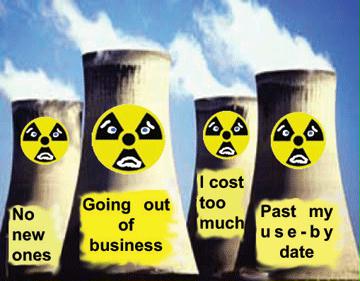
Preface. This is nuts. Sea level rise threatens many nuclear power plants and drought has shut plants down since they need cooling to operate.
As nuclear reactor age, they require more intensive monitoring and preventive maintenance to operate safely. But reactor owners have not always taken this obligation seriously enough. Given that older reactors require more attention from the regulator, not less, it is perplexing that the NRC wants to scale back its inspections of the aging reactor fleet and its responses to safety violations. Six years ago, the US Government Accountability Office pointed out that “NRC’s oversight will soon likely take on even greater importance as many commercial reactors … are reaching or have reached the end of their initial 40-year operating period.” (Lyman 2019).
Alice Friedemann www.energyskeptic.com author of “When Trucks Stop Running: Energy and the Future of Transportation”, 2015, Springer, Barriers to Making Algal Biofuels, and “Crunch! Whole Grain Artisan Chips and Crackers”. Podcasts: Collapse Chronicles, Derrick Jensen, Practical Prepping, KunstlerCast 253, KunstlerCast278, Peak Prosperity , XX2 report
***
Natter, A. 2020. The U.S. May Soon Have the World’s Oldest Nuclear Power Plants. Bloomberg.
In December federal regulators approved Florida Power & Light Co.’s request to let the facility’s twin nuclear reactors remain in operation for another 20 years beyond the end of their current licenses. By that point they’ll be 80, making them the oldest reactors in operation anywhere in the world.
“That’s too old,” said Rippingille, a lawyer and retired Miami-Dade County judge who was wearing a blue print shirt with white sea turtles on it. “They weren’t designed for this purpose
With backing from the Trump administration, utilities across the nation are preparing to follow suit, seeking permission to extend the life of reactors built in the 1970s to the 2050s as they run up against the end of their 60-year licenses.
“We are talking about running machines that were designed in the 1960s, constructed in the 1970s and have been operating under the most extreme radioactive and thermal conditions imaginable,” said Damon Moglen, an official with the environmental group Friends of the Earth. “There is no other country in the world that is thinking about operating reactors in the 60 to 80-year time frame.”
Indeed, the move comes as other nations shift away from atomic power over safety concerns
Critics such as Edwin Lyman, a nuclear energy expert with the Union of Concerned Scientists, argue that older plants contain “structures that can’t be replaced or repaired,” including the garage-sized steel reactor vessels that contain tons of nuclear fuel and can grow brittle after years of being bombarded by radioactive neutrons. “They just get older and older,” he said. If the vessel gets brittle, it becomes vulnerable to cracking or even catastrophic failure. That risk increases if it’s cooled down too rapidly—say in the case of a disaster, when cold water must be injected into the core to prevent a meltdown.
The commission’s decision doesn’t sit well with Philip Stoddard, a bespectacled biology professor who serves as the mayor of South Miami, a city of 13,000 on about 18 miles away from the Turkey Point plant. He keeps a store of potassium iodide, used to prevent thyroid cancer, large enough to provide for every child in his city should the need arise.
“You’ve got hurricanes, you’ve got storm surge, you’ve got increasing risks of hurricanes and storm surge,” said Stoddard, 62, from the corner office in a biology building on Florida International University’s palm-tree lined campus. All of this not only increases the likelihood of a nuclear disaster, it also complicates a potential evacuation, which could put even more lives at risk. “Imagine being in a radiation cloud in your car and you’re sitting there running out of gas because you’re in a parking lot in the freeway,” he said.
Climate change is also one of the main cases against extending the life of Turkey Point, said Kelly Cox, the general counsel for Miami Waterkeeper, a six-person environmental group that has joined with the Natural Resources Defense Council and Friends of the Earth to challenge the NRC’s approval in the United States Court of Appeals for the District of Columbia Circuit. New data show sea level rise in the area reach as high as 4.5 feet by 2070, but regulators from the Nuclear Regulatory Commission didn’t take those updated figures into account, said Cox.
References
Lyman, E. 2019. Aging nuclear plants, industry cost-cutting, and reduced safety oversight: a dangerous mix. Bulletin of the Atomic Scientists.
